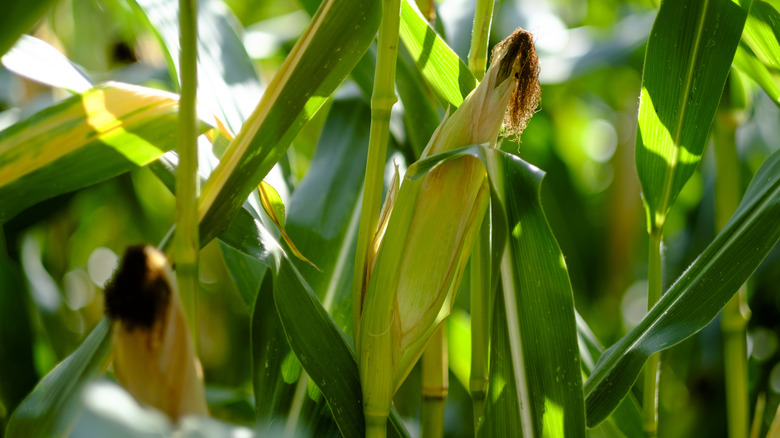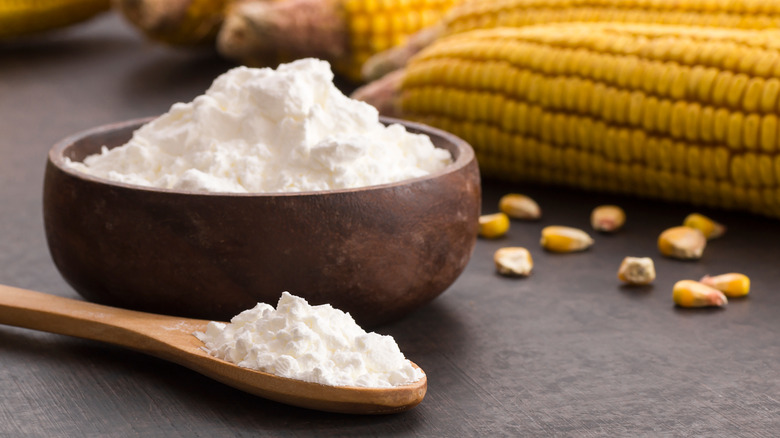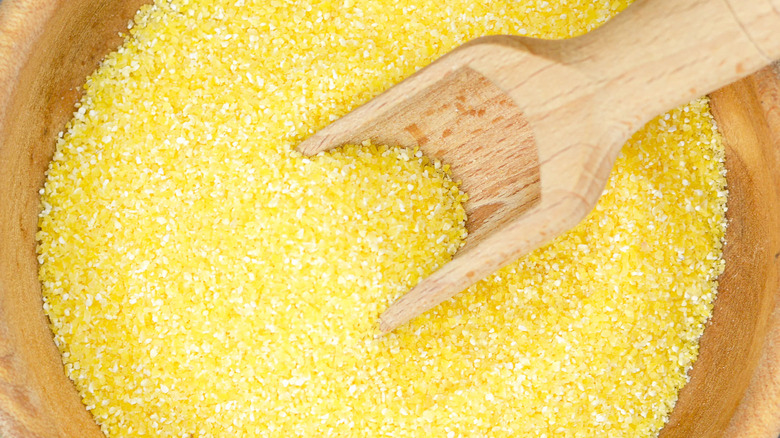What Makes Cornmeal And Cornstarch Different?
Corn: We love to pop it, chop it, stir fry it, butter it, spice it or sweeten it up. We have kids online going viral while singing the praises of corn, and holidays that rely on it — we're looking at you, Thanksgiving. But that's not all we love about corn. This grain can be ground up and baked into some of our favorite dishes, like cast iron cornbread and homemade corn tortillas.
According to the Northern Nester, there are six different corn classifications: dent corn, flint corn, popcorn, flour corn, sweet corn, and pod corn. And even though sweet corn is what is traditionally imagined when we talk about the plant, all these other varieties are also an integral part of our edible ecosystem, just in a manner that's less obvious. For example, we use dent corn quite often to make flour, cornmeal, and cornstarch. Yep! All that and more, but the parts of the corn we use and how we process it are what truly set these ingredients apart.
What is cornstarch?
You may not use it often, but it serves a purpose. Cornstarch is recognizable by its white, powder-like texture that is good for thickening soups, dusting swim caps, chafing skin, and starching laundry. According to MyRecipes, cornstarch was invented in 1842 by Thomas Kingsford, who discovered how to remove the skin from corn kernels and extract their carbohydrates. Healthline considers cornstarch as a "refined carb" because it has been so heavily processed. Very little of the original nutritional value in the corn kernel remains, and the powder itself is flavorless.
But, despite its lack of nutritional value, cornstarch does have a role to play in the kitchen. Healthline points out that cornstarch is completely free from gluten (because it is made entirely of corn) and an awesome substitute for other thickening agents in things like gravy and hollandaise sauce. You can even use cornstarch in place of butter when making pasta!
Cornstarch can be used in place of flour in certain batter recipes, but since cornstarch provides twice the thickening power as flour, you can't swap one completely out for the other (via The Spruce Eats). In bakes, it's recommended that cornstarch be mixed with other flour (gluten-free or otherwise) to successfully create your dish rather than attempting to make a baked good that uses only cornstarch.
What is cornmeal?
Cornmeal is not made from the same stuff as cornstarch. Well... That's not entirely true. They are technically both made from corn, but cornstarch is made from only the "endosperms" found in the middle of corn kernels, while cornmeal is made from dried and ground dent corn kernels with only the germ and bran removed (via Epicurious).
If you've ever picked up a bag of cornmeal at the store without checking what kind it was, you may have been surprised to find that it was finer or coarser than you expected. That's because cornmeal is often ground into different sizes. Bon Appetit reports that the smaller the grind of the cornmeal, the faster liquid is absorbed, and vice versa. There are quite a few cornmeal grid sizes. The smallest grind is what we consider corn flour, which is used to make tortillas and cakes, and coarser cornmeal is commonly utilized in Southern-style cornbread. Polenta and grits are some of the largest ground cornmeal examples.
According to Food History, cornmeal was core to Native Americans' diets. Since corn was domesticated around 5000 BC, it has been integral to Native traditions and nutrition. They commonly baked cornmeal (which was ground using a "handheld stone" known as a manojh) into bread, cakes, and grits. When it comes down to it, cornmeal is more ancient — and more nutritional — than its thin and flaxen cornstarch offspring, but both have and will continue to play a role in our kitchens for years to come.


